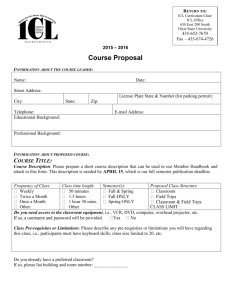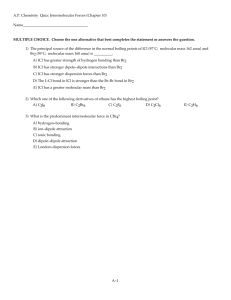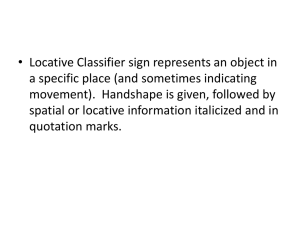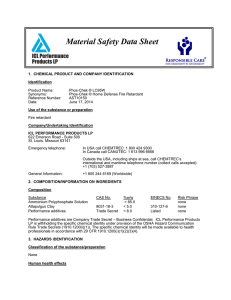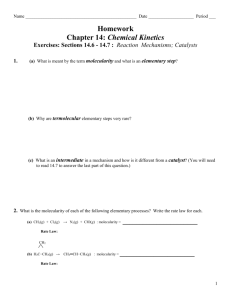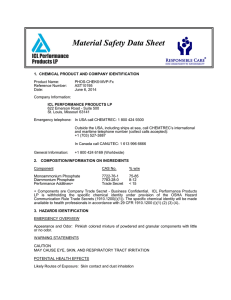MEASUREMENT-THEORETIC FOUNDATIONS OF INTERADJECTIVE-COMPARISON LOGIC
advertisement
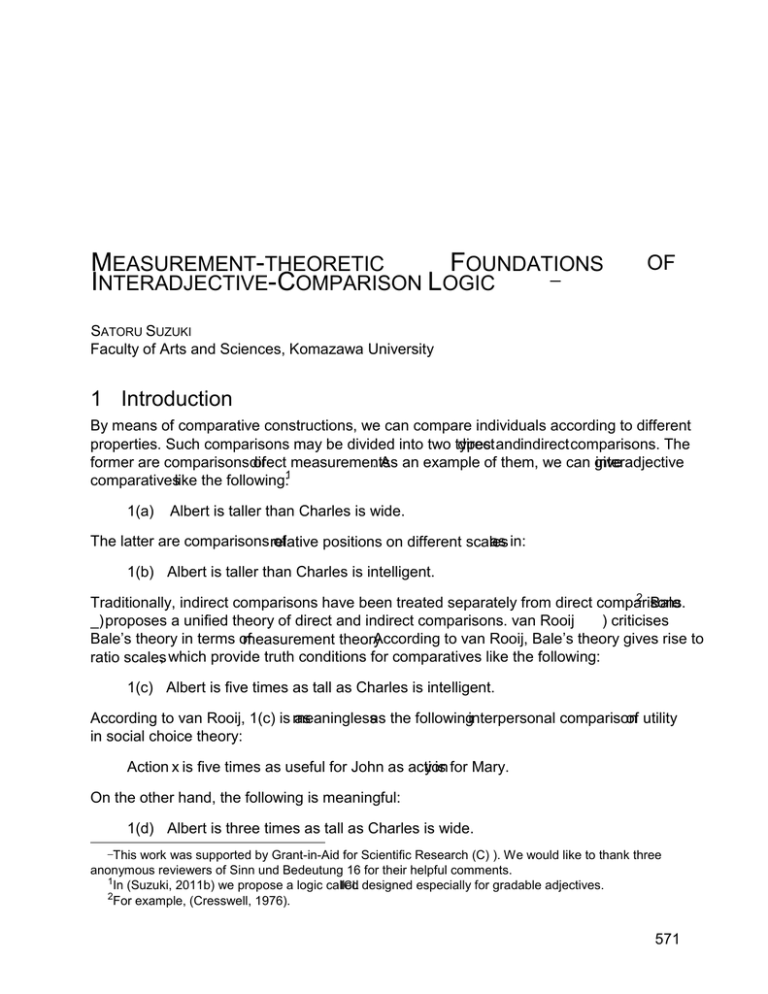
MEASUREMENT-THEORETIC FOUNDATIONS _ INTERADJECTIVE-COMPARISON LOGIC OF SATORU SUZUKI Faculty of Arts and Sciences, Komazawa University 1 Introduction By means of comparative constructions, we can compare individuals according to different properties. Such comparisons may be divided into two types: direct andindirect comparisons. The former are comparisonsdirect of . As an example of them, we can give measurements interadjective comparativeslike the following:1 1(a) Albert is taller than Charles is wide. The latter are comparisons relative of as in: positions on different scales 1(b) Albert is taller than Charles is intelligent. 2 Traditionally, indirect comparisons have been treated separately from direct comparisons. Bale _) proposes a unified theory of direct and indirect comparisons. van Rooij ) criticises Bale’s theory in terms of . According to van Rooij, Bale’s theory gives rise to measurement theory , which provide truth conditions for comparatives like the following: ratio scales 1(c) Albert is five times as tall as Charles is intelligent. According to van Rooij, 1(c) is meaningless as as the followinginterpersonal comparison of utility in social choice theory: Action x is five times as useful for John as action y is for Mary. On the other hand, the following is meaningful: 1(d) Albert is three times as tall as Charles is wide. _ This work was supported by Grant-in-Aid for Scientific Research (C) ). We would like to thank three anonymous reviewers of Sinn und Bedeutung 16 for their helpful comments. 1 ICL designed especially for gradable adjectives. In (Suzuki, 2011b) we propose a logic called 2 For example, (Cresswell, 1976). 571 572 Suzuki 3 There are two main problems with measurement theory : 1. the representation problem —justifying the assignment of numbers to objects, and 2. the uniqueness problem —specifying the transformation up to which this assignment is unique. A solution to the former can be furnished by arepresentation theorem , which establishes that the specified conditions on a qualitative relational system are (necessary and) sufficient for the assignment of numbers to objects that represents (preserves) all the relations in the system. A solution to the latter can be furnished by a , which specifies the transformation uniqueness theorem up to which this assignment is unique. In this paper, we provide truth conditions for interadjective comparatives like the followings: 1(e) Albert is 10 centimetres taller than Catherin is wide. 1(f) Albert is taller than Bernard by more than Charles is wider than Dennis. 1(g) Albert is taller than Bernard by more than Charles is more intelligent than Dennis. In terms of constraints on transformations, measurement theorists distinguish among scales: 4 absolute, ratio, interval, ordinal, nominal, log-interval, and difference scales. These scales are based on the assignment of a measure on a set of individuals (domain). In order to make sense of interadjective comparisons, van Rooij ) thinks of the domain not just as a set of individuals but rather as a set of individual-adjective pairs. He calls co-ordinal scalesordinal scales based on the assignment of a measure on a set of individual-adjectiveco-interval pairs, scalesinterval scales based on it, and co-ratio scales ratio scales based on it. He argues that co-ordinal scales can make comparatives like 1(a) and 1(b) meaningful, and that co-interval scales can account for examples like 1(e), 1(f), and 1(g). Moreover, he suggests that co-ratio scales can make comparatives like 1(d) meaningful. Klein €) analyses comparatives by existentially quantifying over the meaning of like very andfairly . This analysis can provide 1(a) with the following truth modifiers of adjectives condition: 9 f 2 f very; fairly ; quite;::: g( f (tall )( Albert) ^: f ( wide)( Charles) ) : Klein’s analysis gives rise only to a co-ordinal scale. van Rooij ) tries to extend this analysis to co-interval scales and co-ratio scales. to adjective, this analysis f isIftotal and so applicable any then makes all interadjective comparatives meaningful. So van Rooij acknowledges that it is partial. But his approach has such a defect that he does not show how to construct this partial function f . Our strategy in this paper is as follows. We prove, by means of the representation and theuniqueness theorem for , that theorem for interadjective-comparison ordering it log-interval of the scalescan make comparatives like 1(b) and 1(g) meaningful, and, by meansrepresentation 3 Roberts •) gives a comprehensive survey of measurement theory.The mathematical foundation of measurement had not been studied before Hölder A) developed his axiomatisation for the measurement of mass. (Krantz et al., 1971), (Suppes et al., 1989) and (Luce et al., 1990) are seen as milestones in the history of measurement theory. 4 We describe these scales later. Measurement-theoretic Foundations of Interadjective-Comparison Logic 573 and theuniqueness theorem for, that theorem for magnitude estimation it ratio scalescan account for examples like 1(a), 1(d), 1(e), and 1(f). Moreover, we propose conditions under which a model of interadjective comparison and magnitude estimation which gives rise to scalescan give ratio . The semantic structure of 1(c) cannot satisfy some of these conditions. numerical assignments Therefore, we cannot provide 1(c) with its truth condition. The aim of this paper is to propose a new version of logic for interadjective comparisons– ICL Interadjective-Comparison Logic ( ). In terms of measurement theory,model the of the language ICL of can provide reasonable conditions for log-interval scales and ratio scales, andtruth give the conditionsof interadjective comparatives like 1(a), 1(b), 1(c), 1(d), 1(e), 1(f) and 1(g). Moreover, this model can render interadjective comparatives likemeaningless 1(c) . L ICL of ICL, give descriptions The structure of this paper is as follows. We define the language of meaningfulness, scale types, magnitude estimation, and the relation between cross-modality matching and interadjective comparison, define a model M of L ICL , formulate the representation theorem for interadjective-comparison ordering and the uniqueness theorem for it, formulate the ICL representation theorem for magnitude estimation and the uniqueness theorem for it, provide with a satisfaction definition, a truth definition, and a validity definition, touch upon the non firstorder axiomatisability of models ofL ICL , give the truth conditions of the examples 1(a), 1(b), 1(d), 1(e), and 1(f), and give an answer to the question as to why 1(c) is meaningless. 2 Interadjective-Comparison Logic ICL 2.1 Language L ICL of ICL as follows: We define the language Definition 1 (Language) Let V denote a set of individual variables, C a set of individual constants,P a set of n one-place predicate symbols.The languageL ICL of ICL is given by the following rule: t ::= x j a; j ::= Pi (t ) j t i = t j j DERPi ;Pj (t i ; t j ) j IER Pi ;Pj (t i ; t j ) j TER Pi ;Pj k (t i ; t j ) j UERPi ;Pj k ( t i ; t j ) j FDERPi ;Pj (t i ; t j ; t l ; t m) j FIER Pi ;Pj (t i ; t j ; t l ; t m) j>j: j j j ^ j j8 xj ; where x2 V , a 2 C , and Pi ; Pj 2 P : • • • • DERPi ;Pj (t i ; t j ) means thati t is directly iP -er thanj t isj P . IER Pi ;Pj (t i ; t j ) means thati t is indirectly iP -er thanj t is j P . TER Pi ;Pj k (t i ; t j ) means thati t is directly k-times asi P as j t isj P . UERPi ;Pj k (t i ; t j ) means that i t is directly Pi -er thanj t is Pj by n-units of measurement (e.g. (centi)metre, (kilo)gram, ...). • FDERPi ;Pj (t i ; t j ; t l ; t m) means thati t is directly iP -er thanj t by more than l t isj P -er than m. t • FIER Pi ;Pj ( t i ; t j ; t l ; t m) means thati t is indirectly iP -er than m. t j t by more than l t is j P -er than The set of all well-formed formulaeLofICL is denoted byF L ICL . 574 Suzuki 2.2 Semantics 2.2.1 Meaningfulness and scale types Roberts •:p.52, pp.57±) argues the meaningfulness of sentences involving scales. He begins with the the following sentences and considers which seem to be meaningful. 2(a) The number of cans of corn in the local super market at closing time yesterday was at least 10. 2(b) One can of corn weighs at least 10. 2(c) One can of corn weighs twice as much as a second. 2(d) The temperature of one can of corn at closing time yesterday was twice as much as that of a second time. 2(a) seems to be meaningful, but 2(b) does not, for the number of cans is specified without reference to a particular scale of measurement, whereas the weight of a can is not. Similarly, 2(c) seems to be meaningful, but 2(d) does not, for the ratio of weights is the same regardless of measurement used, whereas that of temperature is not necessarily the same. Meaningfulness can be studied by analysing the following of scale defined by the concept admissible transformations of a homomorphism : Definition 2 (Homomorphism) Suppose a relational system 0 0 0 0 0 0 U :=( A; R1; R2;:::; Rp; _1; _2;:::; _q) and anotherV :=( B; R1 ; R2 ;:::; Rp ; _1 ; _2 ;:::; _q ) , where 0 _1; _2;:::; _q ; R20;:::; Rp0 are relations on B, A and B are sets,1;RR2;:::; Rp are relations on A, 1R 0 0 0 _1 ; _2 ;:::; _q are operations on B. f is called a homomorphism from are operations on A, and U 2 into V if, for any a1; a2;:::; ari A, 0 Ri ( a1; a2;:::; ari ) iff Ri ( f ( a1) ; f ( a2) ;:::; f ( ari ) ) ; i = 1; 2;:::; p; and for any a; b 2 A, 0 f ( a _ i b) = f ( a) _ i f ( b) ; i = 1; 2;:::; q: Definition 3 (Admissible Transformation of Scale)Suppose that a scale f is one homomorphism from a relational system U into anotherV , and suppose that A is the set underlyingU and B is the set underlying V . Suppose that F is a function that maps the range of f, that is, the set (fA) := f f ( a) : a 2 Ag into B. Then the composition F _ f is a function from A into B. If F _ f is a homomorphism from U into V , we callF an admissible transformation of f The following provides an example: Example 1 SupposeU :=( N;> ) , V :=( R;> ) , and f : N ! R is given by f( x) := 2x. Then f is a homomorphism from U into V . If F ( x) := x + 5, thenF _ f is a homomorphism from U into V , for we have( F _ f )( x) = 2x + 5, and x > y iff 2x + 5 > 2y + 5: Thus,F : f ( A) ! B is an admissible transformation of f. However, F (ifx) := € x for any x2 f ( A) , thenF is not an admissible transformation, for U into V . F _ f is not a homomorphism from Measurement-theoretic Foundations of Interadjective-Comparison Logic 575 We define meaningfulness in terms of admissible transformations as follows: Definition 4 (Meaningfulness) A sentence involving scales is meaningful iff the truth or falsity is unchanged under admissible transformations of all the scales in question. Roberts •:pp.64·) defines follows: scale typesin terms of the class of admissible transformations as = x. Such 1. The simplest example of a scale is where only admissible transformation F ( x) is a scale is called an . Counting is an example of an absolute scale. absolute scale 2. When the admissible transformations are all the functionsF : f ( A) ! B of the form F ( x) = a x; a > 0, F is called asimilarity transformation, and a scale with the similarity transformations as its class of admissible transformations is called ratioascale. Mass and temperature on the Kelvin scale are examples of ratio scales. According Stevens (Stevens, 1957), varioussensationssuch as loudness and brightness can also be measured in ratio scales. 3. When the admissible transformations are all the functions F : f ( A) ! B of the formF ( x) = , and a corresponding scale is a x + b ; a > 0, F is called apositive linear transformation called aninterval scale. Temperature on the Fahrenheit scale and temperature on the Celsius scale are examples of interval scales. 4. When a scale is unique uporder to , the admissible transformations are monotone increasing functionsF ( x) satisfying the condition thatx _ y iff F ( x) _ F ( y) . Such scales are called . The Mohs scale of hardness is an example of an ordinal scale. ordinal scales 5. In some scales, all one-to-one functions F define admissible transformations. Such scales are callednominal scales . Examples of nominal scales are numbers on the uniforms of baseball players. 6. A scale is called alog-interval scaleif the admissible transformations are functions of the form F ( x) = a xb ; a ; b > 0. Log-interval scales are importantpsychophysics in , where they are considered as scale types for the psychophysical lawsrelating a physical quantity (for example, intensity of a sound) to psychological quantity (for example, loudness of a sound). 7. When the admissible transformationsare functions of the form F ( x) = x + b , a corresponding scale is adifference scale . The so-called Thurstone Case V scale, which is a measure of response strength, is an example of a difference scale. 2.2.2 Magnitude estimation, cross-modality matching, and interadjective comparison Judgments of subjective loudness can be made in laboratory in various ways. Stevens o) classifies four methods. The method of is one of the most common. The magnitude estimation following provides an example: Example 2 (Magnitude Estimation) A subject hears a reference sound and is told to assign it a fixed number. Then he is presented other sounds and asked to assign them numbers proportional to the reference sound. 576 Suzuki Stevens argues that magnitude estimation gives riseratio to a scale. Moreover, he uses the idea of cross-modality matching to test thepower law. It must be noted that the scale corresponding to the power law is alog-interval scale. Krantz z) puts Stevens’s argument that magnitude estimation gives rise to a ratio scale and his idea of cross-modality matching to test the power law on a rigorous measurement-theoretic foundation. In this paper, we try to propose a logic for interadjective comparisonthe model of which is based on Krantz’s measurement theory for magnitude estimation and cross-modality matching. 2.2.3 Model First, we define a model M of L ICL as follows: Definition 5 (Model) M is a M M M ( I F1 ;:::; I Fn ; a1 ; b1 ;:::; •F1 ;:::; •Fn ; ~ F1 ;:::; ~ Fn ; F 1 ;:::; F nM ; _ ) , where sequence • I Fi is a nonempty set of individuals for evaluation iof F , celled a comparison class relative to Fi . • a i M ; bi M ;::: 2 I Fi . I • •Fi is an average individual in • ~ Fi is a zero-point individual inI • F iM _ I Fi . Fi . Fi . • _ is a binary relation onS i = 1nI Fi _ I Fi , called the interadjective-comparison ordering relation, that satisfies the following conditions: 1. _ is a weak order (transitive and connected). 0 0 2. For any ai M ; bi M 2 I Fi and any aj M ; bj M 2 I 0 0 ( bj M ; aj M ) _ ( bi M ; ai M ) . 0 0 Fj , 0 0 0 if ( ai M ; bi M ) _ ( aj M ; bj M ) , then 0 0 3. For any ai M ; bi M ; ci M 2 I Fi and any aj M ; bj M ; cj M 2 I Fj , if ( ai M ; bi M ) _ ( aj M ; bj M ) 0 0 0 0 and ( bi M ; ci M ) _ ( bj M ; cj M ) , then( ai M ; ci M ) _ ( aj M ; cj M ) . 0 0 4. For any a i M ; bi M 2 I Fi , there exist a 1 M ; b1 M 2 I F1 such that ( ai M ; bi M ) _ 0 0 0 0 0 0 ( a1 M ; b1 M ) , where ( ai M ; bi M ) _ ( aj M ; bj M ) := ( ai M ; bi M ) _ ( aj M ; bj M ) and 0 0 ( aj M ; bj M ) _ ( ai M ; bi M ) . 5. For any a1M ; b1M ; c1M ; d1M 2 I F1 , if ( d1M ; c1M ) _ ( a1M ; b1M ) _ ( d1M ; d1M ) , then 0 0 0 0 there exist 1aM ; b1 M 2 I F1 such that( d1M ; b1 M ) _ ( a1M ; b1M ) _ ( a1 M ; c1M ) . 6. Suppose that 1a( 1) M ; a1( 2) M ;:::; a1( i ) M ;::: is a sequence of equally spaced elements of I F1 , that is, ( a1( i + 1) M ; a1( i ) M ) _ ( a1( 2) M ; a1( 1) M ) _ ( a1( 1) M ; a1( 1) M ) for any Measurement-theoretic Foundations of Interadjective-Comparison Logic 577 a1( i + 1) M ; a1( i ) M in the sequence. If the sequence is strictly bounded (that is, if there exist b1M ; c1M 2 I F1 such that( b1M ; c1M ) _ ( a1( i ) M ; a1( 1) M ) for any a1( i ) M in the sequence), then it is finite. Condition 2 postulates that reversing pairs should be reversing the ordering.The following provides an example: Example 3 (Reversal of Pairs)In 1(b), if a i is much taller than b i, and a j 0 is slightly more 0 0 intelligent than bj 0, so that ( ai M ; bi M ) _ ( aj M ; bj M ) , then bi is much shorter than ai , but bj 0 is 0 0 ( bj M ; aj M ) _ ( bi M ; ai M ) . only slightly duller than ja0 , so that ( ai M ; bi M ) behavequalitativelylike ratios or differences with respect to Condition 3 says that pairs _ . The following provides an example: Example 4 (Ratios and Differences)Pairs( ai M ; bi M ) behave with respect _toin much the same aj 0 bj 0 aj 0 ai bi ai as _ 0 and _ 0 implies that _ 0 (for positive real numbers) andi € a bi _ aj 0€ bj 0 bi bj ci ci ci cj and bi € ci _ bj 0€ cj 0 implies ai € ci _ aj 0€ cj 0. I F1 _ I F1 pair. Condition 4 postulates that any pair( ai M ; bi M ) should be equivalent to some Condition 5 postulates that intermediate-level individuals can be chosen denselywithin I F1 . Condition 6 postulates that_ should have anArchimedean Property . The following provides an example: Example 5 (Archimedean Property) However small the pair( a1M ; b1M ) in tallness, if one can ( 1) M ; a1( 2) M ;::: such that any pair( a1( i + 1) M ; a1( i ) M ) in tallness is find a sequence of tallness1a ( a1( n) M ; a1( 1) M ) in tallness becomes equivalent to( a1M ; b1M ) in tallness, then the overall interval indefinitely large. We can prove the following representation theorem for interadjective-comparison ordering by modifying the method of (Krantz et al., 1971): _ Theorem 1 (Representation for Interadjective-Comparison Ordering)If is an interadjective-comparison ordering relation of Definition 5, then there exist functions i : I fi ! 0 0 + M M 2 I M M 2 I _ _ _ _ _ i n) and any aj ; bj j _ n) , Fi ( 1 Fj ( 1 R ( 1 i n) such that for anyi a ; bi 0 2( e) M M ( ai ; bi ) _ ( aj 0 M ; bj 0 M f j ( aj M ) f i ( ai M ) _ ) iff : 0 f i ( bi M ) f j ( bj M ) We can also prove the following uniqueness theorem for interadjective-comparison ordering by modifying the method of (Krantz et al., 1971): Theorem 2 (Uniqueness for Interadjective-Comparison Ordering)If f 0i ( 1 _ i _ n) are any + other such functions asi of f Theorem 1, then there exist a i ; b 2 R ( 1 _ i _ n) such that 0 f i = a i f ib : Remark 1 f i defines a log-interval scale. 578 Suzuki 2.2.4 Magnitude estimation and ratio scale We specify some conditions under which magnitude estimationleads to a ratio scale5. These conditions follow from the following three consistency conditions: 1. the magnitude-pair consistency condition, 2. the pair consistency condition, and 3. the magnitude-interadjective-comparison consistency condition. We state these three consistency conditions.Suppose that an experimenter is performing a magnitude estimation of a subjectI on ai M 2 I Fi and assigns to ai M the Fi . The experimenter fixes psychological magnitude p. We assume that all magnitudes are positive. Next, the experimenter asks the subject to assign to each bi M 2 I Fi a magnitudeq depending onai M and p. This is written in symbols as follows: ME i ( bi M j ai M ; p) = q; whereME i is the magnitude estimate for bi M whenai M is assigned a magnitude p. In particular, ME i ( ai M j ai M ; p) = p: In the variant of magnitude estimation called pair estimation, a pair ofai M and bi M from I Fi are presented, and then the experimenter asks the subject to give a numerical estimate of, as it were, the qualitative ratio ofai M to bi M . We denote this estimate by PEi ( ai M ; bi M ) . It is reasonable to assume that PEi corresponds to_ as follows: 2( f ) ( ai M ; bi M ) _ ( cj M ; dj M ) iff PEi ( ai M ; bi M ) _ PEj ( cj M ; dj M ) : Magnitude estimates and pair estimates are often assumed to satisfy the following magnitude-pair + M 2 I : for any ci consistency condition i and anyp 2 R , 2( g) PEi ( ai M ; bi M ) = ME i ( ai M j ci M ; p) : ME i ( bi M j ci M ; p) Moreover, it is often assumed that pair estimates behave like rations, that is, they satisfy the following pair consistency condition : for any ai M ; bi M ; ci M 2 I i , 2( h) PEi ( ai M ; bi M ) _PEi ( bi M ; ci M ) = PEi ( ai M ; ci M ) : If i = 1, 2(h) yields 2( i ) PE1( a1M ; b1M ) _PE1( b1M ; c1M ) = PE1( a1M ; c1M ) : In interadjective-comparison matching , we usually fixai M 2 I M match. The experimenter then asks the subject to bfind i 2 I bj M 2 I Fj . This is written in symbols as follows: IM ji ( bj M j aj M ; ai M ) = bi M : 5 We owe this subsection to (Roberts, 1979:pp.186Š) andaj M 2 I Fj and say that they Fi that matches a given individual Fi Measurement-theoretic Foundations of Interadjective-Comparison Logic 579 In particular, IM ji ( aj M j aj M ; ai M ) = ai M : It is reasonable to assume that if aj M is matched by iaM and bj M by bi M , then the corresponding : qualitative ratios are judged equal 2( j ) If IM ji ( bj M j aj M ; ai M ) = bi M , then( bj M ; aj M ) _ ( bi M ; ai M ) : It is often assumed that magnitude estimation and interadjective-comparison matching are related by the followingmagnitude-interadjective-comparison consistency condition : ME i ( IM ji ( bj M j aj M ; ai M ) j ci M ; q) ME j ( bj M j cj M ; q) = : ME i ( ai M j ci M ; p) ME j ( aj M j cj M ; q) 2( k) That is, if bj M is matched withbi M in the interadjective-comparison matching, where aj M is given M M as matched withai , then the ratio of the magnitude estimatebi of to the magnitude estimate of of to the magnitude estimate aofj M ai M on thei th adjective equals the ratio of the magnitude bj M on thej th adjective for any reference estimate p for ci M andq for cj M . If IM ji ( bj M j aj M ; ai M ) = bi M M M andai = ci , 2 (g) and 2 (k) yield 2( l ) ME i ( bi M j ai M ; p) = PEj ( bj M ; aj M ) p ( biifM ; ai M ) _ ( b1M ; a1M ) , then 2(l) becauseME i ( ai M j ai M ; p) = p. It is reasonable to assume that holds for j = 1: 2( m) M M If ( bi ; ai ) _ ( b1M ; a1M ) , then ME i ( bi M j ai M ; p) = PE1( b1M ; a1M ) : p We can prove the following representation theorem for magnitude estimation by modifying the method of (Krantz, 1972): Theorem 3 (Representation for Magnitude Estimation)Suppose that_ is an interadjective; ME i ; PEi and IM isatisfy comparison ordering relation of Definition 5. Moreover, suppose_ that : Rf+ ! R+ such that if fi s satisfy 2 2(f), 2(i), 2(j) and 2(m). Then there exists a power function (e), then f i ( bi M ) f ( q) = ; 2( n) ME i ( bi M j ai M ; p) = q iff f i ( ai M ) f ( p) 2( o) 2( p) PEi ( ai M ; bi M ) = r iff f i ( ai M ) = f ( r ) ; and f i ( bi M ) If IM ji ( bj M j aj M ; ai M ) = bi M , then f i ( bi M ) f i ( ai M ) = . f j ( bj M ) f j ( aj M ) We can also prove the following uniqueness theorem for magnitude estimation by modifying the method of (Krantz, 1972): 580 Suzuki Theorem 4 (Uniqueness for Magnitude Estimation)If f 0i and f 0 also satisfy 2 (e) and 2 (n) + through 2(p), then there exist there exist a i ; b 2 R ( 1 _ i _ n) such that 0 0 f i = a i f i b and f = f b : Remark 2 Both f i and f define log-interval scales. We now obtain the following corollary of Theorem 3 and Theorem 4: Corollary 1 (Ratio Scale) ME i defines a ratio scale. 2.2.5 Satisfaction, truth and validity We define an assignment function and its extension as follows: Definition 6 (Assignment Function and Its Extension)Let V denote a set of individual I a set of individuals. variables,C a set of individual constants and • We call s: V ! I an assignment function. • We define the extension of s as a function s˜ : V [ C ! I such that 1. For any x2 V , s˜( x) = s( x) , and 2. For any a2 C , s˜( a) = aM . We provideICL with the following satisfaction definition relative to M , define the truth inM by means of satisfaction, and then define validity as follows: Definition 7 (Satisfaction, Truth and Validity) What it means for M to satisfyj 2 F L in symbolsM j= L ICL j [s] is inductively defined as follows: • M j= L ICL P(t )[ s] • M j= L ICL t 1 = t 2[s] iff iff ICL with s, s˜(t ) 2 PM . s˜( t 1) = s˜(t 2) . • 2(q) M j= L ICL DERPi ;Pj (t i ; t j ) [s] iff if _ ; ME i ; PEi and IM i satisfy 2(f), 2(i), 2(j) and 2(m), thens˜(t i ) 2 I Pi and s˜( t j ) 2 I Pj and MEi ( s˜( t i ) j~ Pi ; 0) > ME j ( s˜(t j ) j~ Pj ; 0) . • 2(r) M j= L ICL IER Pi ;Pj (t i ; t j )[ s] iff s˜(t i ) 2 I Pi and s˜(t j ) 2 I Pj and ( s˜(t i ) ; •i ) _ ( s˜(t j ) ; •j ) , where( s˜(t i ) ; s˜(t j )) _ ( s˜(t k ) ; s˜(t l ) ) :=( s˜( t k ) ; s˜(t l )) _ ( s˜(t i ) ; s˜(t j )) . • 2(s) M j= L ICL TER Pi ;Pj k (t i ; t j ) [s] iff if _ ; ME i ; PEi and IMi satisfy 2(f), 2(i), 2(j) and 2(m), thens˜(t i ) 2 I Pi and s˜( t j ) 2 I Pj and MEi ( s˜( t i ) j~ Pi ; 0) = k _ME j ( s˜( t j ) j~ Pj ; 0) . • 2(t) M j= L ICL UERPi ;Pj k (t i ; t j ) [s] iff if _ ; ME i ; PEi and IMi satisfy 2(f), 2(i), 2(j) and 2(m), thens˜(t i ) 2 I Pi and s˜( t j ) 2 I Pj and MEi ( s˜( t i ) j~ Pi ; 0) = ME j ( s˜(t j ) j~ Pj ; 0) + k. Measurement-theoretic Foundations of Interadjective-Comparison Logic • 2(u) M j= L ICL 581 if _ ; ME i ; PEi and IM i satisfy 2(f), 2(i), ME i ( s˜(t i ) j s˜(t j ) ; p) > and s˜(t l ) ; s˜(t m) 2 I Pj and p FDERPi ;Pj (t i ; t j ; t l ; t m)[ s] iff 2(j) and 2(m), then s˜(t i ) ; s˜(t j ) 2 I Pi ME j ( s˜(t l ) j s˜(t m) ; q) . q • 2(v) M j= L ICL FIER Pi ;Pj (t i ; t j ; t l ; t m)[ s] (t i M ; s˜(t j ) ) _ ( s˜(t l ) ; s˜( t m)) . • M j= L ICL >. • M j= L ICL : j [s] iff • M j= L ICL j ^ y [s] = M 6j iff L ICL M j= L iff s˜(t i ) ; s˜( t j ) 2 I Pi and s˜( t l ) ; s˜(t m) 2 I Pj and j [s]. ICL j [s] and M j= L ICL y [s]. • M j= L ICL 8xj [s] iff for any d 2 I , M j= L ICL j [s( xj d) ], where s( xj d) is the function that is exactly like s except for one thing: for the individual variable x, it assigns the individual d. This can be expressed as follows: s( xj d)( y) := ( s( y) d if if y, x y = x: If M j= L ICL j [s] for all s, we write M j= L ICL j and say thatj is true in M . If j is true in all models ofL ICL , we writej= L ICL j and say thatj is valid. 2.3 Non First-Order axiomatisability of models ofL ICL The semantic structure ICL of is sorich that ICL has the following meta-logical property. L Theorem 5 (Non First-Order Axiomatisability) The class of models of axiomatisable. ICL is not first-order Remark 3 We can express the Archimedean Property by means of infinite quantifier sequences. In order to express them, we need infinitary logic. 2.4 Truth conditions of examples When a modelM of L ICL is given, the truth conditions of the examples 1(a), 1(b), 1(d), 1(e), 1(f), and 1(g) are as follows: • 1(a) Albert is taller than Charles is wide. M j= L ICL DERtall;wide( Albert; Charles) iff if _ ; ME 1; ME 2; PE1; PE2; IM 1 and IM 2 satisfy 2(f), 2(g), 2(i), 2(j) and 2(m), then Albert 2 I tall and Charles 2 I wide and ME 1( Albertj~ tall ; 0) > ME 2(Charlesj~ wide; 0) ( * 2( q) ) . 582 Suzuki • 1(b) Albert is taller than Charles is intelligent. M j= L ICL IER tall;intelligent( Albert; Charles) iff Albert 2 I and( Albert; •tall ) _ (Charles; • intelligent) ( * 2( r ) ) . tall and Charles 2 I intelligent • 1(d) Albert is three times as tall as Charles is wide. M j= L ICL TER tall;wide3( Albert; Charles)[ s] iff if _ ; ME 1; ME 2; PE1; PE2; IM 1 and IM 2 satisfy 2(f), 2(g), 2(i), 2(j) and 2(m), then Albert 2 I tall and Charles 2 I wide and ME 1( Albertj~ tall ; 0) = 3 _ME 2(Charlesj~ wide; 0) ( * 2( s)) . • 1(e) Albert is 10 centimetres taller than Charles is wide. M j= L ICL TER tall;wide10( Albert; Charles) iff if _ ; ME 1; ME 2; PE1; PE2; IM 1 and IM 2 satisfy 2(f), 2(i), 2(j) and 2(m), then Albert 2 I tall and Charles 2 I wide and ME 1( Albertj~ tall ; 0) = ME 2(Charlesj~ wide; 0) + 10 ( * 2(t )) . • 1(f) M Albert is taller than Bernard by more than Charles is wider than Dennis. j= if _ ; ME 1; ME 2; PE1; PE2; IM 1 L ICL FDERtall;wide( Albert; Bernard; Charles; Dennis) iff andIM 2 satisfy 2(f), 2(i), 2(j) and 2(m), then Albert; Bernard2 I tall andCharles; Dennis2 ME 1( Albertj Bernard; p) ME 2(Charlesj Dennis; q) I wide and > ( * 2( u)) . p q • 1(g) Albert is taller than Bernard by more than Charles is more intelligent than Dennis. M j= L ICL FIER tall;wide( Albert; Bernard; Charles; Dennis) iff Albert; Bernard 2 I tall andCharles; Dennis2 I wide and( Albert; Bernard) _ (Charles; Dennis) ( * 2( v) ) . 2.5 Why is 1(c) meaningless? Let us now return to the question as to why 1(c) is meaningless: 1(c) Albert is five times as tall as Charles is intelligent. In order to provide 1(c) with its truth condition in terms of 2(s), PE1 and ME 2 must satisfy the instance of 2(m): 2( w) ME 2( b2M j a2M ; p) = PE1( b1M ; a1M ) , p 2 I tall and anya2M ; b2M 2 I intelligent: If ( b2M ; a2M ) _ ( b1M ; a1M ) , then for anya1M ; b1M However, in the semantic structure of 1(c), we cannot construct PE1 and ME 2 that satisfy 2(w). Therefore, we cannot provide 1(c) with its truth condition in terms of 2(s). 3 Concluding remarks In this paper, we have proposed a new version of logic for interadjective comparisons– ICL Interadjective-Comparison Logic ( ). In terms of measurement theory, the model of the language of ICL can provide reasonable conditions for log-interval scales and ratio scales, give the truth Measurement-theoretic Foundations of Interadjective-Comparison Logic 583 conditions of interadjective comparatives like 1(a), 1(b), 1(d), 1(e), 1(f) and 1(g), and render interadjective comparatives like 1(c) meaningless. This paper is only a part of a larger measurement-theoretic study.We are now trying to construct such logics as 1. 2. 3. 4. 5. dynamic epistemic preference logic (Suzuki, 2009b), dyadic deontic logic (Suzuki, 2009a), vague predicate logic (Suzuki, 2011c,d), threshold utility maximiser’s preference logic (Suzuki, 2011a), and a logic of questions and answers by means of measurement theory. References Bale, A. C. 2008. A universal scale of comparison. 31:1-. Linguistics and Philosophy Cresswell, M. J. 1976. The semantics of degree.Montague In , ed. B Partee, 261Ê. grammar New York: Academic Press. Hölder, O. 1901. Die Axiome der Quantität und die Lehre von Mass. Berichte über die Verhandlungen der Königlich Sächsischen Gesellschaft der Wissenschaften zu Leipzig. 53:1´. Mathematisch-Physikaliche Classe Klein, E. 1980. A semantics for positive and comparative adjectives. Linguistics and Philosophy 4:1¥. Krantz, D. H. 1972. A theory of magnitude estimation and cross-modality matching. Journal of Mathematical Psychology 9:168‘. Krantz, D. H., et al. 1971. , Vol. 1. New York: Academic Press. Foundations of measurement Luce, R. D., et al. 1990. , Vol. 3. San Diego: Academic Press. Foundations of measurement Roberts, F. S. 1979. . Reading: Addison-Wesley. Measurement theory van Rooij, R. 2011. Measurement and interadjective comparisons. 28:335– Journal of Semantics 358. Stevens, S. S. 1957. On the psychophysical Psychological law. 64:153•. Review Suppes, P., et al. 1989. , Vol. 2. San Diego: Academic Press. Foundations of measurement Suzuki, S. 2009a. Measurement-theoretic foundation of preference-based dyadic deontic logic. In Proceedings of the second international workshop on logic, rationality, and interaction,(lori-ii) ed. X. He et al., Vol. 5834 of LNAI. Heidelberg: Springer-Verlag. Suzuki, S. 2009b. Prolegomena to dynamic epistemic preference logic. In New frontiers in artificial of , 177Š. Heidelberg: Springer-Verlag. intelligence, ed. H. Hattori et al., Vol. 5447 LNAI Suzuki, S. 2011a. A measurement-theoretic foundation of threshold utility maximiser’s preference logic. Journal of Applied Ethics and Philosophy 3:17•. Suzuki, S. 2011b. Measurement-theoretic foundations of gradable-predicate logic. In Proceedings , of the Eighth Workshop on Logic and Engineering of Natural Language Semantics (LENLS 8) ed. A. Butler, 165€. Tokyo: JSAI. Suzuki, S. 2011c. Measurement-theoretic foundations of probabilistic model of jnd-based vague predicate logic. In Proceedings of the third international workshop on logic, rationality, and interaction (lori-iii) , ed. H. van Ditmarsch et al., Vol. 6953 of LNAI, 272Å. Heidelberg: Springer-Verlag. 584 Suzuki Suzuki, S. 2011d. Prolegomena to salient-similarity-based vague predicate logic. In New frontiers in artificial intelligence, ed. T. Onoda et al., Vol. 6797 of LNAI, 75É. Heidelberg: SpringerVerlag.
